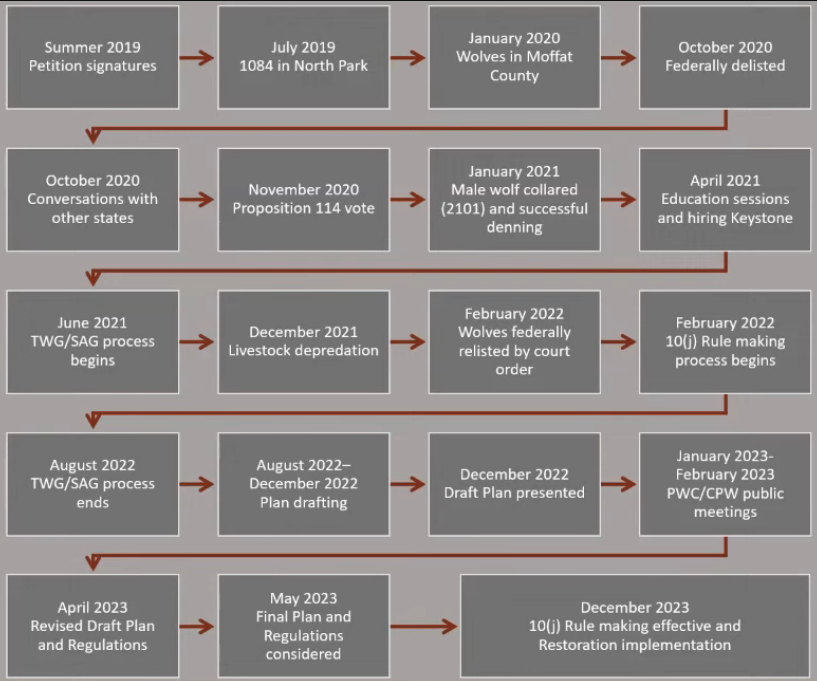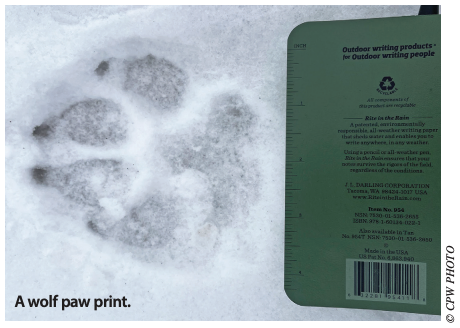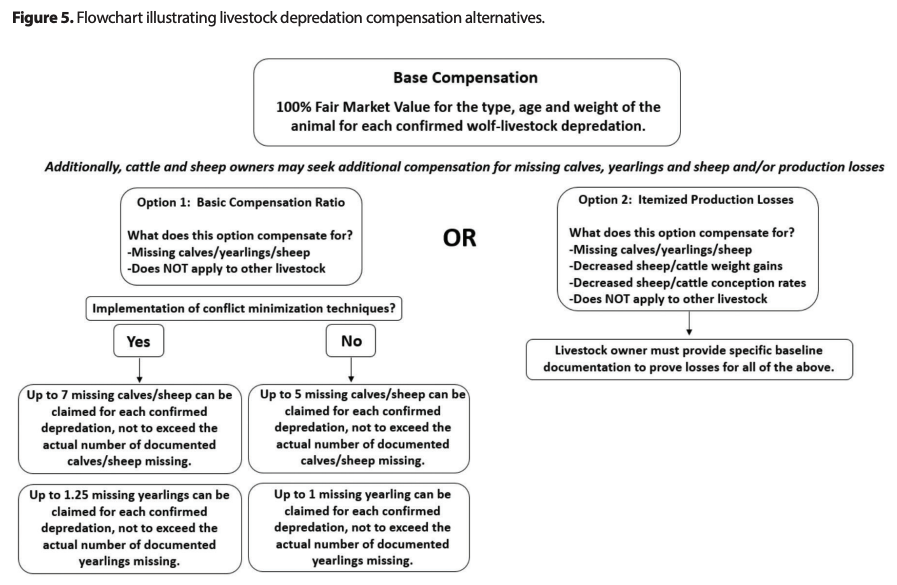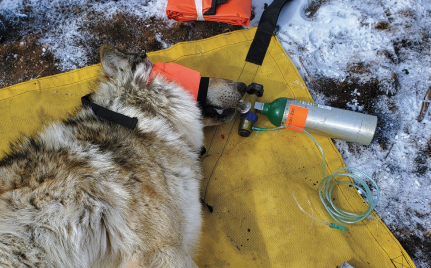GLENWOOD SPRINGS, Colo. — Following years of intense meetings, public comment and outreach, the Colorado Parks and Wildlife (CPW) Commission officially approved the final Colorado Wolf Restoration and Management Plan on Wednesday afternoon.
The plan was approved following a two-step process that wrapped at the commission's meeting on Wednesday in Glenwood Springs. The approval means CPW biologists can officially introduce wolves west of the Continental Divide before the end of 2023.
This final plan is the result of two and a half years of Technical Working Group (TWG) and a Stakeholder Advisory Group (SAG) discussions — the groups met monthly between June 2021 and August 2022 — and hearings that welcomed public input.
CPW staff used these findings to develop a draft version of the plan, which was changed, updated and ultimately finalized and approved on Wednesday afternoon.
“Congratulations to this entire group," CPW Commission Chair Carrie Besnette Hauser said immediately after the vote. "It’s sort of a little emotional. This is a big deal. Thank you for the compromise. Thank you for the dialogue. Thank you for the healthy debate in this day and age when we just don’t see it happening.”
Upon learning of the approval, Colorado Gov. Jared Polis briefly hopped on Zoom to congratulate the commission and thanked the countless people behind the comprehensive work that went into reaching the final plan.
"This science-based plan is the result of months of planning, convening stakeholder and expert working groups, and offering live and public comment opportunities, while factoring in the biological needs of the species, and creating the best possible chance for these amazing animals to be successfully restored to our state," Polis in a follow-up statement.
Earlier in the meeting, CPW Commission Chair Hauser said while everybody may not have agreed on every detail, it is the culmination of years of effort, best intentions and thoughtful compromise.
"And it is a plan that has been guided by a Stakeholder Advisory group, the Technical Working Group, and thousands of individuals and organizations that have weighed in on the public input process," she said.
In total, more than 4,000 members of the public expressed their perspectives on this plan.
Eric Odell, species conservation program manager with CPW, has been at almost every wolf-related meeting the CPW Commission has held since 2020. After summarizing the countless hours of work that had gone into the creation of this plan, he commented on what's ahead.
“The plan will accomplish what Colorado revised statue 33-2-105.8 set out to do," Odell said. "Wolves will be restored in Colorado. The wolf population will grow and conflicts will be addressed. We will learn by doing, taking an adaptive management approach. Mistakes will be made. Successes will be won. We will certainly hear what we’re doing wrong, and hopefully hear what we’re doing right.”
In addition to this update, two related bills passed on seconds in the Colorado House this week — Senate Bill 255 Wolf Depredation Compensation Fund and Senate Bill 256 Management of Gray Wolves Reintroduction. The latter prohibits CPW from restoring wolves to Colorado if the U.S. Secretary of the Interior has not made final determination that the gray wolf population is a nonessential experimental population in accordance with the 10(j) rule of the Endangered Species Act, which is detailed below. Hauser said the commission does not hold a position on that bill.
Background of wolves in Colorado
Gray wolves are currently classified as an endangered species by the State of Colorado. They are native to Colorado, but were exterminated and functionally extinct by the 1940s. About 6,000 of the animals now live in the Northern Rockies, Pacific Northwest and Western Great Lakes after the federal government reintroduced the wolves in Yellowstone National Park in the mid-1990s.
In the summer of 2019, the Rocky Mountain Wolf Action Project began circulating petitions asking voters to put a question on the 2020 ballot asking if wolves should be reintroduced. The exact question read:
Shall there be a change to the Colorado Revised Statutes concerning the restoration of gray wolves through their reintroduction on designated lands in Colorado located west of the Continental Divide, and, in connection therewith, requiring the Colorado Parks and Wildlife Commission, after holding statewide hearings and using scientific data, to implement a plan to restore and manage gray wolves; prohibiting the commission from imposing any land, water, or resource use restrictions on private landowners to further the plan; and requiring the commission to fairly compensate owners for losses of livestock caused by gray wolves?
The group collected more than 215,000 signatures, which were submitted to the Colorado Secretary of State Office in December 2019. It was certified the following January, and was set to appear on the November 2020 ballot.
This went on to become Proposition 114.
In the November 2020 state election, voters chose to pass Proposition 114, which mandated that CPW develop a plan to start reintroducing and managing gray wolves in western Colorado and to take steps to begin reintroductions by Dec. 31, 2023. Despite initial polling that found extremely strong support for the initiative, the measure passed with only 50.91% — 1,590,299 votes — of the public voting in favor of the proposition. Opposing voters made up 49.09%, or 1,533,313 votes. It was an inconsistent topic across the state, CPW said.

Since then, CPW has been working with experts and the public to develop the Colorado Wolf Restoration and Management Plan. The first draft of the plan was released in December. The final draft was discussed in April and the CPW Commission officially approved the final plan on Wednesday.
CPW said its primary goal with this plan is "to recover and maintain a viable, self-sustaining wolf population in Colorado, while concurrently working to minimize wolf-related conflicts with domestic animals, other wildlife, and people."
Meanwhile, in northwestern Colorado, gray wolves were already starting to trickle into the state. In July 2019, CPW said it was investigating a gray wolf sighting in Jackson County. The wolf was wearing a tracking collar. They confirmed it was from a pack in Wyoming. About six months later, in February 2020, officials confirmed the first documentation of a wolf pack in Colorado in more than 70 years.
In May 2021, CPW identified a collared wolf that has been living in Colorado since 2019 as a female. The wolf dispersed from the Snake River Pack in Wyoming and has been staying in the Jackson County area of northwestern Colorado for the last two years. She has been traveling with a male and their movements were consistent with "potential denning behavior." In June 2021, Colorado became home for its first wolf litter since the 1940s. Early the following year, in February 2022, CPW collared its first gray wolf born in Colorado.

Key issues the wolf reintroduction plan addresses
CPW has said it plans to manage wolves in Colorado with impact-based management, allowing the organization to have maximum flexibility throughout the system.
Simply put, the plan reads that if wolves are creating a conflict, CPW must manage to resolve the problem on a case-by-case basis. This will include management tools like non-lethal conflict minimization, education, damage payments and when necessary, lethal take of wolves. The first line of defense should be non-lethal, the plan reads. However, in certain conditions, the initial response may include killing of wolves.
The plan notes seven key issues considered the most significant for wolf conservation and management. They, as listed, are:
- Social tolerance for wolves and economic impacts
- Wolf recovery
- Wolf management with respect to wolf-livestock interactions
- Wolf management with respect to wolf-ungulate interactions
- Wolf interactions with other wildlife species
- Wolves and human safety concerns
- Monitoring and research
The document acknowledges both the negative and positive impacts of having wolves on Colorado's landscape.
Wolves may prey on and harass livestock or guard animals, attack domestic pets, and reduce hunting or viewing opportunities for ungulates.
"Some negative impacts may be low on a statewide scale but can be acute on a local or individual scale, with social and economic impacts for those that are affected," the draft reads.

On the other hand, where CPW observes positive impacts, they should be "recognized and fostered," the draft plan continues. This could include reductions in ungulates in an overpopulated area, habitat improvement due to less herbivory, removing ill or injured animals from a herd, and intrinsic value.
Attacks by wolves on humans are "exceedingly rare," the document reads, and there are no documented accounts of a person killed by a wolf in North America between 1900 and 2000. The animals generally fear people.
In the rare cases they have attacked a person, the majority were the result of a diseased wolf (like rabies), a starving wolf, a person guiding livestock or a child in an area where prey is scarce, a wolf defending its territory and den sites, wolf habituation to humans, or a wolf's defensive behavior associated with a food source, or feeling threatened. Any person is allowed to kill a gray wolf in self-defense or the defense of another person.
CPW said it plans to distribute information on wolf safety as their numbers increase, just like it does regularly with black bears, mountain lions, moose, rattlesnakes and other animals.
More details on the restoration plan
The wolf reintroduction efforts will require 30 to 50 wolves to be transferred to Colorado over a period of three to five years. CPW will aim to capture 10 to 15 wolves annually from multiple packs over this timeframe. After the release of those 30 to 50 animals, active reintroduction efforts will stop and CPW will focus solely on monitoring to see if the population is self-sustaining.
The reintroduction will be considered successful if the survival rate is high, the wolves stay in Colorado, packs are formed and if wolves born in Colorado survive to also reproduce.
If the survival rate is less than 70%, a protocol review would be initiated, the plan reads.
All wolves released in Colorado will have a GPS satellite collar, according to the plan, and as they become established, CPW will aim to have one to two wolves in each pack collared.
The plan reads that "it is desirable" to source these wolves from the northern Rockies, like Idaho, Montana or Wyoming. They may also come from Oregon or Washington. One of the concerns raised during the public comment period involved questions about governors of those states refusing to donate wolves to Colorado.
All incoming wolves will be flown or driven in as quickly as possible.
They will then be released, as state statute requires, west of the Continental Divide. Based on previous wolf releases in other states, CPW expects the newly released wolves to travel anywhere from 22 to 140 miles from where they were freed. With this in mind, they will be released a minimum of 60 miles from the state border with Wyoming, Utah, New Mexico and the sovereign tribal lands in southwestern Colorado, the latter of which was requested by the Southern Utes.

Over time, Coloradans should expect the packs to expand widely, including to the Front Range.
Keeping in mind geographic restrictions, CPW determined two large areas for consideration of a wolf release in the winter. These two places are detailed in the above graphic and include:
- Along the I-70 corridor between Glenwood Springs and Vail, down to the Roaring Fork Valley
- Along the Highway 50 corridor between Monarch Pass (east of Gunnison) and Montrose
Releases in the first year will only occur in the northern area on state and private land. Federal land is not included here because CPW does not have the staffing or financial resources to undertake the National Environmental Policy Act analysis, which is required for any releases on federal land.
Specific release locations will not be released to the public, but CPW will reach out to potentially affected stakeholders.
How will Colorado monitor the wolf recovery?
CPW will use a phased approach to manage wolves, based on the minimum known number of the animals.
A minimum wintertime count will be the metric to monitor early phases of reintroduction, and this includes both wolves that were brought in by humans and wolves that naturally migrated into the state. Once this number reaches 50 for four successive years, the plan instructs downlisting wolves from State Endangered to State Threatened. If 150 are found anywhere in Colorado for two successive years — or 200 are found anywhere — they will be reclassified as delisted, nongame wildlife.
If this point is reached, the CPW will conduct a population viability analysis to assess extinction probability using Colorado-specific demographic parameters, the plan reads.
None of those numbers should be used as population objectives, the document reads.
This section of the plan is purposefully general because it is forecasting so far in the long-term.CPW acknowledged in the plan that at some point in the future, wolf management may need to be considered in a way that is not outlined in the plan simply because the information is not yet available.
"These discussions would only occur after wolves have successfully been recovered and removed from the State Threatened and Endangered list," the plan reads. "The long-term management of wolves should be impact- and science-based, with consideration of biological and social science as well as economic and legal considerations."
Under current state law, it is illegal to hunt wolves.
Once CPW reintroduces wolves, how will they be managed?
The United States Fish and Wildlife Service (USFWS) is working to provide management flexibility of wolves by designating them under section 10(j) of the federal Endangered Species Act. Under section 10(j), the USFWS can designate a population of a listed species as experimental if it's set to be released into a natural habitat outside the animals' current home range.
That population is treated as threatened under the Endangered Species Act, regardless of how it is designated elsewhere. Treating them like this allows the USFWS to devise management programs and special regulations for that population, according to the USFWS.
The 10(j) rule is not yet in effect for Colorado wolves. This means that management tools — which may include aversive conditioning and lethal take to protect people and livestock, especially following reintroduction — are limited, as gray wolves are still listed as an endangered species in Colorado.
If the 10(j) rule is adopted, as is anticipated, CPW would have increased management flexibility.
During Wednesday's meeting, many members of the public, as well as elected officials, said they feel this rule needs to be adopted before Colorado reintroduces any wolves to the land.
Senate Bill 256 would prohibit CPW from restoring gray wolves before the 10(j) rule is adopted.
This reintroduction and management plan lists three categories of conflict — livestock interactions, wildlife species interactions, and other situations — plus management tools available for use based on the phase the population is in at the time of the conflict. These include both lethal and non-lethal methods.
Non-lethal hazing does not injure a wolf, but does scare it off with loud noises. There is also non-lethal hazing that includes potential minor injury, like rubber bullets.
The plan describes conditions in which lethal take of wolves, if authorized, would be used. CPW, and possible USFWS as well, would look at several aspects of the state's wolf packs, such as population growth and pack dynamics and distribution to determine if lethal control is required. Physical evidence should be at-hand, the document reads. This can include dead or injured livestock or working dogs.
Livestock compensation and conflict minimization programs
The Colorado Wolf Restoration and Management Plan says it is legally required to provide fair compensation to livestock owners for any economic losses if their animals are injured or killed by wolves.
If livestock or a guard animal is injured or killed, the wolf-livestock compensation program will pay for 100% of fair market value compensation, up to $15,000 per animal. This is up from $8,000 in a previous draft of the wolf reintroduction plan.

These funds would come from a funding source other than the sale of hunting and fishing licenses, though the plan only says "CPW will pursue a variety of funding sources" for both livestock compensation and conflict minimization programs.
There is no compensation program for loss of pets or hunting dogs. Lethal control of wolves in the act of killing a pet or hunting dog, or just after the fact, is not allowed, as consistent with other game damage laws and regulations, according to the plan.
CPW will provide educational materials to livestock owners on ways to avoid wolf-livestock interactions, which includes managing any carcasses on the property, herd composition and more.
Livestock owners who live around wolves will receive loaned scare devices, electrified fencing and other temporary conflict minimization materials, with instructions on use, on a case-by-case basis. At the same time, CPW will analyze the risk to those specific livestock.
Monitoring, research and reporting for wolf restoration
Both monitoring and research are crucial parts of wolf management in Colorado, the plan reads.
"Whereas monitoring is an effort of systematic observation/measurement to assess population status and trends, research is an effort to test theory and use data to examine the efficacy of wildlife management techniques (or tools)," according to the plan. "Both are important for wolf management. Wolf research in Colorado will provide data that can be interpreted and used to inform management decisions."
As the packs become established in Colorado, CPW will work to collar at least one to two wolves. This may become challenging as the population grows, but CPW will prioritize the collaring efforts based on pack proximity to livestock and any history of conflict.
Aside from collars, CPW will also monitor wolves via winter track counts, aerial surveys, hair samplings, scat collections, howling surveys, trail cameras and visual observations from both experts and the general public.
When CPW is doing live captures, they will briefly examine the wolf's health and send samples to the CPW Wildlife Health Laboratory.

One of the aspects CPW will study is wolf mortality. In most cases, wild wolves die of infectious disease, starvation and intraspecific strife, the plan reads. It notes the importance of also monitoring cases where a wolf was killed by a person.
Part of monitoring Colorado's wolves includes monitoring their prey. This was one of the greatest concerns from the public, especially from residents on the Western Slope, when wolf reintroduction discussions began around the state.
"CPW extensively monitors all ungulate populations throughout the state," the final plan reads. "The reintroduction of wolves to the state will not cause any of these efforts to diminish. In fact, CPW has already invested in expanded, pre-wolf reintroduction ungulate monitoring, which is only likely to expand into additional areas as wolf populations grow and disperse across the state."
Forward-looking research will look at the impact of wolves in Colorado. This will include both social effects, like tolerance for wolves, and ecological effects, like wolf interactions with livestock, prey and other wildlife.
Due to the intense public interest in this plan, CPW will release an annual report about the restoration actions that happened the previous year. However, the CPW Commission can request an update at any time if there are new developments. A formal review of the plan's progress is scheduled for five years after the reintroduction efforts are completed.
Education and outreach for wolf reintroduction
The Colorado Wolf Restoration and Management Plan says it's more important than ever for the public to learn about Colorado wolves in an unbiased manner and armed with facts for honest discussions.
It's a two-way street — in turn, wildlife managers must receive accurate information on sightings, depredations and wolf behavior.
CPW will have several educational partners, including the USFWS, U.S Department of Agriculture’s Wildlife Services Program Animal Plant Health Inspection Service, U.S. Forest Service, Bureau of Land Management, Colorado Department of Agriculture, tribal governments, private sector professionals, and other state agencies, the plan lists.
Funding needs to support wolf plan
Various funding sources are needed to conserve and manage gray wolves in Colorado.
Managing wolves will likely come with a higher price tag than the current plans for other carnivores, like black bears and mountain lions, the plan says. According to Proposition 114, the state budget for 2023-2024 for the implementation of the gray wolf reintroduction plan would increase to $800,000 per year.
Several programs outlined in the plan, like monitoring wolves and their prey populations, do not currently exist in CPW, so additional staff, financial resources and possibly legislative updates may be needed to support the program, the plan reads. It adds that livestock depredation investigations will require a "significant investment" of staff's time.
If you see a gray wolf, CPW asks that you fill out its wolf sighting form here. If possible, wildlife officers ask that you take photos and videos.





